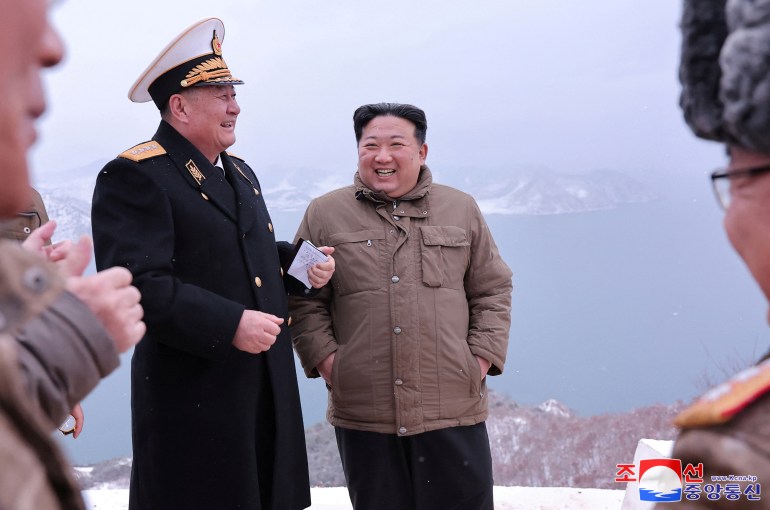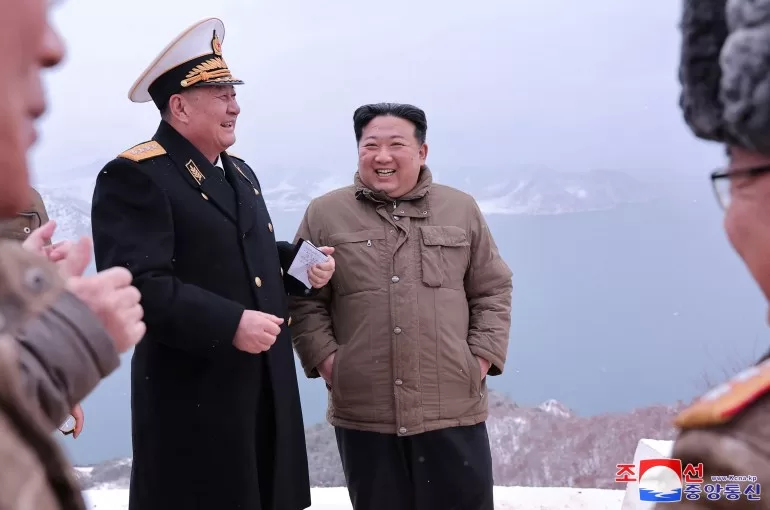Second test of weapon in days as North Korea accelerates efforts to modernise its navy.
The newly-developed Pulhwasal-3-31 missiles “flew in the sky above the East Sea … to hit the island target”, the KCNA news agency reported on Monday, adding that Kim “guided” the launch.
It shared photos of Kim at an undisclosed location pointing at a missile in the sky and laughing with members of the military. In other images, huge clouds of white smoke obscured the actual launch platform.
South Korea’s military announced on Sunday that multiple missiles had been launched from waters near the North Korean port of Sinpo, where Pyongyang operates a shipyard that manufactures naval assets including submarines. It did not go into further detail.
The Pulhwasal-3-31 is a new generation of nuclear-capable cruise missile that Pyongyang first tested last Wednesday, as it seeks to enhance the weapons capability of the country’s navy.
The testing of cruise missiles, which are jet-propelled and fly at lower altitudes, is not banned under United Nations sanctions imposed over North Korea’s nuclear weapons programme that outlaw ballistic missile testing.
KCNA said the SLCMs were in the air for 7,421 seconds and 7,445 seconds – approximately two hours – but did not say how far they flew.
North Korea’s exact sea-based launch capabilities remain unclear, and previous tests have been carried out from older vessels, including from a submerged platform, rather than an actual submarine.
Kim expressed “great satisfaction” over Sunday’s test, according to KCNA, noting North Korea’s determination to build a “powerful naval force”.
The North Korean leader separately inspected “the building of a nuclear submarine” and discussed issues related to the construction of other new warships, the report added without giving details.
“They will focus on improving naval power in the East Sea and test weapons systems that can be mounted on submarines, with the first attempt being this strategic cruise missile,” Yang Moo-jin, president of the University of North Korean Studies told the AFP news agency.
“In the future, it will lead to the development of submarine-launched ballistic missiles and nuclear-powered submarines, which will have a much higher impact than SLCMs,” he added.

Proven SLBM capability would take North Korea’s arsenal to a new level, allowing deployment far beyond the Korean Peninsula and a second-strike capability in the event of an attack.
Choi Il, a retired South Korean Navy submarine captain, said once a nuclear-tipped SLCM becomes operational, it will pose a “new threat” to South Korea.
“North Korea will be equipped with a two-track nuclear attack means, with the capabilities of mass destruction of a SLBM and precision strike of a SLCM,” he said.
In recent months, North Korea has tested a variety of weapons, including ballistic missile systems under development and an underwater drone.
Last September, Kim launched the country’s first nuclear attack submarine, which analysts said was probably designed to carry ballistic and cruise missiles and appeared to be modified from an existing diesel-powered submarine.
KCNA said the submarine marked the beginning of a new chapter for North Korea’s navy.
